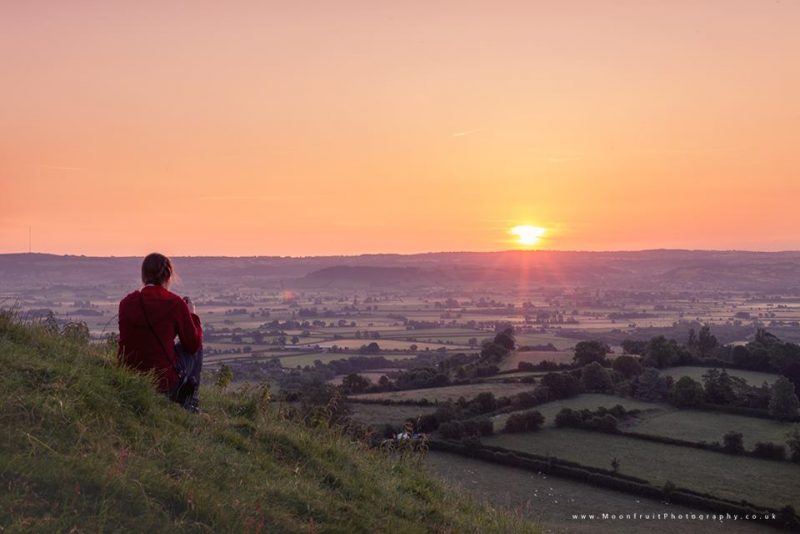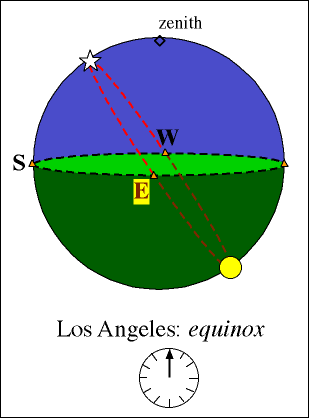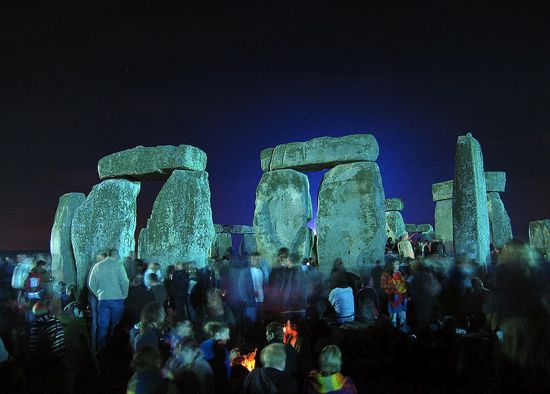2022 June solstice: All you need to know
June 21, 2022
The sun rises farthest north on the horizon – and is highest in the sky at local noon – at the summer solstice.
Satellite views of Earth on the solstices and equinoxes. From left to right, a June solstice, a September equinox, a December solstice, and a March equinox. Read more about these images, which are via Robert Simmon (Sigma Space Corporation)/ NASA.
What is it? The June solstice marks the sun’s northernmost point in our sky for this year.
When is the next one? The next June solstice will fall at 9:14 UTC (4:14 a.m. CDT) on Tuesday, June 21, 2022.
Note: On this solstice, the sun will be directly overhead at noon as viewed from the Tropic of Cancer. For us in the Northern Hemisphere, the June solstice marks the shortest nights and longest days of the year. For the Southern Hemisphere, it marks the longest nights and shortest days. After this solstice, the sun will be moving southward in the sky again.
Check this out … the Breathing Earth. It’s a year of seasonal transformations on our planet, including the June solstice. John Nelson created this animation, using images from the NASA Visible Earth team. Read more about the animation via John Nelson.
What is a solstice?
Ancient cultures knew that the sun’s path across the sky, the length of daylight, and the location of the sunrise and sunset all shifted in a regular way throughout the year.
In fact, they built monuments such as Stonehenge in England and Machu Picchu in Peru to follow the sun’s yearly progress.
Today, we know that a solstice is an astronomical event, caused by Earth’s tilt on its axis and by its orbital motion around the sun.
Indeed, the Earth doesn’t orbit upright. Instead, our world is tilted on its axis by 23 1/2 degrees. Through the year, this tilt causes Earth’s Northern and Southern Hemispheres to trade places in receiving the sun’s light and warmth most directly. In fact, our planet is closest to the sun in January, during the Northern Hemisphere’s winter.
Waiting for the dawn to arrive at Stonehenge, summer solstice 2005. Image via Wikimedia Commons/ Andrew Dunn. Read more about the summer solstice at Stonehenge in 2022.
Where should I look for signs of the June solstice in nature?
Everywhere.
For all of Earth’s creatures, nothing is so fundamental as the length of the day. After all, the sun is the ultimate source of almost all light and warmth on Earth’s surface.
If you live in the Northern Hemisphere, you might notice the early dawns and late sunsets, and the high arc of the sun across the sky each day. You might see how high the sun appears in the sky at local noon. And, also be sure to look at your noontime shadow. Around the time of the solstice, it’s your shortest noontime shadow of the year.
If you’re a person who’s tuned in to the out-of-doors, you know the peaceful, comforting feeling that accompanies these signs and signals of the year’s longest day.

Solstice sunrise via Sarah Little-Knitwitz, Glastonbury Tor, Somerset, U.K

Solstice sunset via EarthSky Facebook friend Lucy Bee in Dallas, Texas.
Is the June solstice the first day of summer?
No world body has designated an official day to start each new season, and different schools of thought or traditions define the seasons in different ways.
In meteorology, for example, summer begins on June 1. And every schoolchild knows that summer starts when the last school bell of the year rings.
Yet June 21 is perhaps the most widely recognized day upon which summer begins in the Northern Hemisphere and upon which winter begins on the southern half of Earth’s globe. There’s nothing official about it, but it’s such a long-held tradition that we all recognize it to be so.
It has been universal among humans to treasure this time of warmth and light.
For us in the modern world, the solstice is a time to recall the reverence and understanding that early people had for the sky. Some 5,000 years ago, people placed huge stones in a circle on a broad plain in what’s now England and aligned them with the June solstice sunrise.
We may never comprehend the full significance of Stonehenge. But we do know that knowledge of this sort wasn’t limited to just one part of the world. Around the same time, Stonehenge was being constructed in England, two great pyramids and then the Sphinx were built on Egyptian sands. If you stood at the Sphinx on the summer solstice and gazed toward the two pyramids, you’d see the sun set exactly between them.
Hello, summer solstice! Image via Abigail Hart.
Why doesn’t the longest day have the hottest weather?
People often ask:
If the June solstice brings the longest day, why do we experience the hottest weather in late July and August?
This effect is called the lag of the seasons. It’s the same reason it’s hotter in mid-afternoon than at noontime. Earth just takes a while to warm up after a long winter. Even in June, ice and snow still blanket the ground in some places. The sun has to melt the ice – and warm the oceans – and then we feel the most sweltering summer heat.
Ice and snow have been melting since spring began. Meltwater and rainwater have been percolating down through snow on the tops of glaciers.
But the runoff from glaciers isn’t as great now as it’ll be in another month, even though sunlight is striking the Northern Hemisphere most directly around now.
So wait another month for the hottest weather. It’ll come when the days are already beginning to shorten again, as Earth continues to move in orbit around the sun, bringing us closer to another winter.
And so the cycle continues.
Bottom line: The 2022 June solstice happens on June 21 at 09:14 UTC. That’s June 21 at 04:14 a.m. CDT in North America. This solstice – the beginning of summer in the Northern Hemisphere – marks the sun’s most northerly point in Earth’s sky.
Visit EarthSky Tonight for easy-to-use night sky charts and info. Updated daily.
Celebrate the summer solstice as the Chinese philosophers did
Why the hottest weather isn’t on the longest day
The earth is tilted at an angle of 23.5 degrees from the horizontal of the plane of rotation so as you can see from the diagram

On September 23 and March 21, the suns rays fall directly on the equator but on June 22 the suns rays are perpendicular at an angle of 23.5 degrees to the north of the equator while at the equator the angle of incidence is 23.5 degrees while on December 22 the suns rays are perpendicular on places 23.5 degrees to the south of equator while at the equator the angle of incidence is 23.5 degree. Thus for people, the sun appears to move to the north from December 22 to June 22 while from June 22 to December 22 it appears to move south.
Sun’s path on the vernal + autumnal equinoxes
Side view







Leave a Reply
You must be logged in to post a comment.